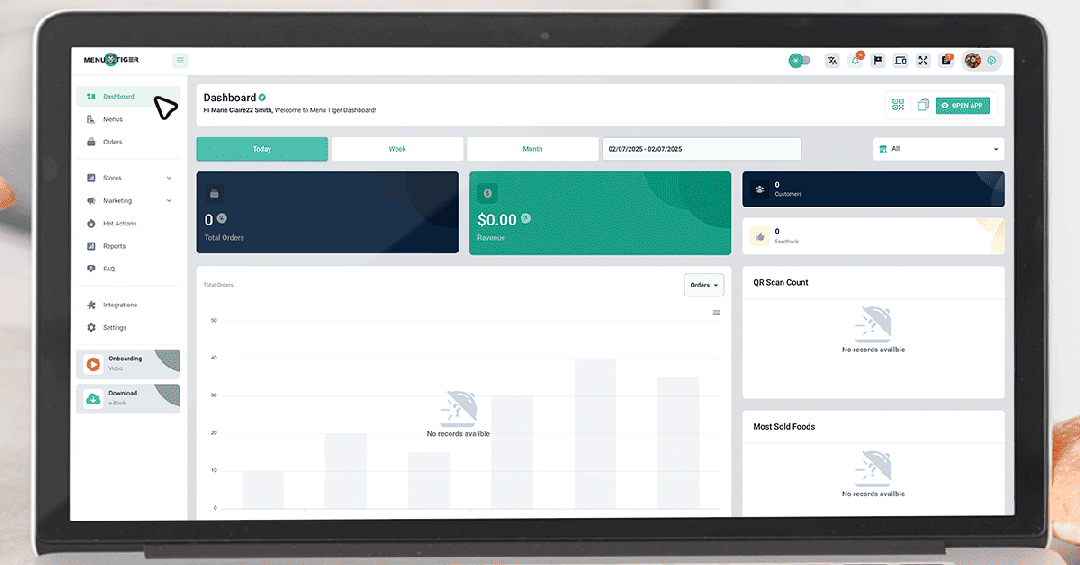Businesses run on data. You might think they should be based on money or market demand, but think again—and think hard.
Just like any other business, data and restaurant analytics lets operators make smart decisions that align with their goals and customer needs. Without these numbers and figures, you might drift into the volatile restaurant industry without an anchor to stabilize and secure your business.
But where do you get your data? And how do you analyze them to gain insights?
Your point-of-sale, restaurant order management system, business review sites, and marketing software are reliable sources. You can run a restaurant SWOT analysis and create reports using these software to generate business insights.
The next thing you need to do now is use the insight to improve your restaurant. And that’s what this article is all about.
Table of Contents
ToggleKey restaurant data collection pointers to keep a tab on
Tackling data is overwhelming, especially if you think all the figures presented are usable.
The thing is, not every graph and number is impactful to your business. So, you need to shift your focus to the essentials.
Point of sale (POS) data
There are two types of POS systems: legacy and cloud-based. The latter offers granulated data you can use to develop insights.
Take the Loyverse POS system, for example. This cloud-based POS system provides its users sales data, product data, inventory management, employee management and tracker, and customer data.
This allows you to spot trends in various aspects of your restaurant service. It’s comprehensive and laid out in a single software.
Inventory data
Your restaurant inventory system keeps a tab on what needs to be restocked, what has been unnecessarily overstocked, and what has been staying on the shelf for too long that you might want to get rid of them soon.
Noting your inventory levels helps in cutting your food costs and food waste.
Another important detail is your employee data, specifically their payroll and schedule.
Employee data
For one, familiarizing yourself with the payroll system gives you a better understanding of how much you allocate to labor costs.
Two, knowing how the scheduling works ensures you are not overstaffed during off-peak hours and understaffed during the busiest days. This also helps you swap shifts when needed.
To manage your employees’ shifts and reduce overstaffing, you can use a staff scheduling software like Agendrix, which helps build schedules, manage time off requests, and improve overall employee productivity.
Feedback or review data

Google My Business, Yelp, social media accounts, and other online review sites are where you can get direct feedback from your customers.
Multiple negative reviews of a service or food warrant you to address the issue and improve. Positive feedback ultimately means you must maintain your offerings, if not enhance them.
Customer data
This is how you get insights into your customers’ purchasing behavior.
This includes how often they order, what items on your menu they frequently order, or at what time of the month or year they normally visit you.
You can track this data through your POS system, restaurant management software, or delivery apps.
Migrating data from JSON to MySQL can further help centralize and structure this information, making it easier to analyze customer trends and improve decision-making.
Understanding how your customers transact and interact with your restaurants allows you to deploy promotions tailored to their demands.
You can achieve this by using embedded analytics solutions in your restaurant software.
Promotion data
Deploying seasonal promotion is a proven profit-generating strategy. However, knowing what type of campaign to implement and when to launch them is key to a successful promotion.
The data lies in your restaurant marketing tools and promo trackers.
Check out the promos that generated sales, engagement, and positive reviews from your patrons, and find out what made it any different from all the other campaigns you sent out.
10 ways to drive sales with restaurant analytics
So, you’ve got your data and extracted your analysis on them. Next thing to do is make realistic action plans.
Here are 10 strategies to leverage your restaurant data analytics:
1. Optimize your menu design and prices
Getting your restaurant menu pricing and design right with analytics boils down to understanding your numbers and aligning them with customer behavior.

For pricing, start by analyzing the cost of each dish—ingredients, prep time, and overhead—and compare that to the selling price. Your goal is to maximize the contribution margin by focusing on highly profitable items and adjusting prices on less profitable ones.
Testing small price increases can also reveal your customers’ price tolerance.
For example, premium dishes can often handle higher prices without impacting demand, while more value-oriented items may need to stay competitively priced.
Menu design, consequently, plays a big role in guiding customer choices.
Analytics can show you which dishes perform best and where customers tend to look first on your menu. Use that insight to highlight high-margin items—place them in prominent spots like the top right corner of a traditional menu or feature them as chef’s recommendations.
Items that pair well together, like appetizers and signature cocktails, can also be grouped or bundled to increase average spending per customer.
2. Upsell and cross-sell effectively
Training is key. Teach your team to look for opportunities to upsell in a natural, conversational way.
For example, if a customer orders a steak, your staff could suggest a specific wine pairing by saying, “Our Malbec has been really popular tonight—it pairs beautifully with the steak you ordered.”
It’s less about pushing and more about enhancing the experience.
Cross-selling works well when staff frame it as adding value. Let’s say a customer orders your Smoked Salmon Scramble.
A server might say, “Many guests love adding avocado to that—it really complements the flavors.” This approach feels personal and tailored, which makes customers more likely to say yes.
Another tactic is for your team to focus on creating moments of excitement.
For instance, train them to describe the dishes vividly when introducing specials, highlighting flavors or preparation techniques.
Finally, role-playing during staff meetings can work wonders. Have your team practice scenarios where they upsell or cross-sell based on your analytics.
The goal is to make these suggestions sound effortless and genuine, so they’re offering guidance, not making a hard sell. When customers feel cared for and not just “sold to,” they’re more likely to trust the recommendations—and come back for more.
3. Cut excess food cost
If you’re ready to act on the analytics insights, focus on a few key strategies to cut food costs.
First, streamline your menu by focusing on high-margin items and reducing dishes with low demand or expensive, underutilized ingredients. Simplifying your menu can also improve operational efficiency.
Second, tighten up inventory management by implementing a “first in, first out” (FIFO) system to minimize spoilage and ensure regular inventory audits to reduce theft or loss.
Third, portion control is crucial. Train your kitchen team to use standardized recipes and measuring tools to avoid overportioning, which can quietly eat into your profits.
Additionally, build stronger relationships with suppliers to negotiate better prices or bulk discounts and consider sourcing seasonal or local ingredients to save on costs.
Finally, monitor and reduce food waste by repurposing scraps into soups, sauces, or specials and offering flexible portion sizes for customers who may not finish large servings.
These steps, combined with regular reviews of food cost metrics, can significantly boost your bottom line.
4. Implement happy hour on downtime
Promoting the happy hour strategically is crucial for success.
Use your analytics to guide you—post about the special on social media when your audience is most active, include it in email newsletters, and update your website to reflect the new offer.
If your restaurant caters to a local crowd, targeted ads or flyers in nearby offices can also be effective.
On the operational side, adjust staffing to match the expected demand, making sure that there’s a balance between excellent service and controlled labor costs.
Once the happy hour is live, ensure to track its performance.
Monitor sales, foot traffic, and customer feedback to see if it’s meeting your goals. If Tuesdays from 3 to 5 PM still aren’t buzzing, consider tweaking the promotion—perhaps adding another menu item, shifting the timing, or experimenting with the price.
Real-time data can help you refine and align the plan with your objectives. This way, your happy hour isn’t just a one-time experiment but an adaptable strategy that continuously improves.
5. Identify the most profitable branch
With the analytics from your branches in hand, you’re in a strong position to drive meaningful change. Identify your top-performing branch and understand what makes it successful.
Analyze the factors contributing to its profitability — menu composition, pricing strategies, staff efficiency, or even local marketing efforts.
Use these insights as a blueprint for improving your other locations. At the same time, pay close attention to underperforming branches.
Look for patterns in the data: Are food costs too high, labor schedules inefficient, or foot traffic low? Tailor solutions to these specific challenges, such as revising the menu to highlight high-margin items, retraining staff, or increasing visibility with targeted marketing.
Remember that analytics can also guide you in customizing the menu for different branches. If certain dishes perform better in specific locations, consider tailoring your offerings to regional preferences.
You may even discover that ghost kitchens, delivery-only operations, could be a profitable alternative in areas with low dine-in traffic.
6. Improve restaurant seating arrangement

Data from your POS system, reservation platform, or even table tracking software can reveal patterns in customer behavior.
For example, you might notice that certain tables turn over faster than others, or that specific areas in your dining room are more popular during peak hours.
With this insight, you can rethink how to position tables to maximize traffic flow, improve server accessibility, and create a better guest experience.
Or your analytics show that two-tops are in high demand on weeknights, but you have too many larger tables taking up floor space.
You could adjust by reconfiguring some larger tables into smaller ones to meet the demand.
It’s about blending the hard numbers with thoughtful design to create a space that works for both your customers and your team.
When done right, analytics-driven seating arrangements can increase table turns, boost revenue, and even make your staff’s job easier. It’s a win across the board.
7. Create better marketing campaigns
Using restaurant analytics to create better marketing campaigns is all about understanding your audience and tailoring your efforts to meet their needs.
Think about it—your point-of-sale system, reservation platform, and even your website traffic are gold mines of data.
You can track which menu items are most popular, when your peak dining times are, and even the demographics of your customers.
For instance, if you notice a spike in dessert sales on weekends, you could run a “sweet deal” promotion to drive even more sales during those times.
You can also use customer data to create targeted email marketing campaigns. Say you’ve got a group of regulars who always order wine.
Why not send them an exclusive invite to a wine-tasting event? Or, if your analytics show a slow weekday, you could introduce a happy hour special and promote it to nearby offices or through social media ads targeting locals.
Pairing this approach with Usercentrics ad tracking can help you measure campaign effectiveness across channels while staying privacy-compliant, ensuring your marketing spend delivers the best ROI.
It’s really about using the numbers to make decisions that feel personalized, which builds customer loyalty and keeps people coming back.
8. Adjust staff size
Sales and foot traffic data can help identify peak hours and days, such as busy lunch shifts during weekdays or high dinner traffic on weekends.
This ensures you schedule more staff during the busy times and scale back when it’s quieter.
Plus, tracking table turnover rates and customer wait times can reveal gaps in service efficiency. If long wait times occur during peak hours, it might signal the need for more front-of-house or kitchen staff.
Historical data also clarifies seasonal trends, such as holidays or local events, allowing you to prepare staffing levels in advance.
Your staff performance metrics, like tables served or dishes prepared per hour, provide valuable insights to optimize shift allocations.
9. Provide better food and service
Your bestsellers should always be consistent in quality, and you might even be able to adjust pricing slightly to boost profits.
On the other hand, if a dish isn’t selling, maybe it needs a recipe tweak, better placement on the menu, or it’s time to take it off completely.
Service speed is another big one. If customers are waiting too long for their food or tables aren’t turning over quickly enough, your data can tell you why.
Maybe the kitchen is getting backed up, or servers need better training on efficiency. Small adjustments, like refining workflows or making sure you have the right number of staff during peak hours, can make a huge difference.
Your inventory data also helps cut down on food waste—if you’re consistently tossing out ingredients, it’s a sign to adjust your ordering or find creative ways to use them in specials.
Then there’s customer experience. If you notice regular guests always ordering the same dish, why not personalize their experience?
A simple gesture, like recommending a dish based on their past orders or offering a loyalty perk, can turn them into even bigger fans of your place.
Pricing is another area where data helps—by tracking costs and profit margins, you can find that sweet spot where customers feel they’re getting great value, and you’re still making a healthy profit.
Lastly, don’t ignore customer reviews and feedback. If people keep mentioning slow service or inconsistent food, that’s your cue to make adjustments.
10. Enhance your website
A good web design for restaurants means it’s user-friendly, responsive, and free of unnecessary ads.
If your analytics reveal peak dining hours, optimize your online reservation system by promoting off-peak bookings.
For online orders, ensure your site can handle demand and offer pre-order incentives. Use customer trends to personalize promotions, such as targeted pop-ups featuring frequently ordered dishes or seasonal favorites.
If most visitors browse via mobile, prioritize a clean, fast-loading experience with easy navigation for reservations and ordering.
Location data can guide region-specific promotions, like offering delivery deals to high-order areas. Highlight top-rated menu items with customer testimonials to build trust and encourage new visitors to try them.
If blog content or specific pages attract high engagement, expand on those topics to drive traffic.
Finally, monitor bounce rates and improve page speed, simplify navigation, and make key details—like menu, hours, and contact info—immediately accessible.
By leveraging these insights, your website becomes a powerful tool to attract, engage, and convert customers.
How to use a restaurant ordering system as your analytics tool

MENU TIGER is more than just a restaurant order management system. It’s a comprehensive tool designed to enhance your restaurant’s operation through detailed analytics.
Here’s what it can offer you:
Sales analytics
The software provides broad sales reports, allowing you to identify peak hours and top-selling dishes. This data enables you to optimize staffing levels and tailor your menu to customer preferences.
Menu analytics and insights
The platform analyzes your menu’s performance, highlighting popular items and those that are less favored. With these insights, you can make informed decisions to adjust your offerings, guaranteeing your menu aligns with customer tastes and maximize profitability.
Purchase analytics
By tracking ingredient usage through their Loyverse integration feature, MENU TIGER helps you manage inventory effectively.
This POS-smart QR code menu integration ensures you maintain optimal stock levels, reducing waste and preventing shortages.
Customer feedback
Gathering and analyzing customer feedback through the platform allows you to understand diner satisfaction and areas for improvement.
This continuous feedback loop is necessary for refining your services and enhancing the overall dining experience.
Takeaway: Restaurant data collection forecasts your business’ growth
It’s not just about great food. Success in the restaurant industry is about making data-driven decisions that guarantee efficiency and profitability.
By leveraging restaurant analytics from your restaurant order system or software, POS systems, customer reviews, and marketing tools, you gain a clear picture of what works and what doesn’t.
The real advantage lies in how you use this data: you can refine your menu, optimize staff schedules, tailor promotions, and improve service to meet customer expectations.
And to ensure you get the most granulated data for your restaurant, choose an analytics tool that best suits your needs.
Check out MENU TIGER. You can create an account for free and see why restaurants are loving this software.
FAQs
Restaurant data analytics involves collecting, analyzing, and interpreting data related to a restaurant’s operations, such as sales, inventory, customer behavior, and staff performance. It helps identify trends, optimize decision-making, improve efficiency, and enhance the customer experience, ultimately driving profitability and growth.
Data analytics in the food industry involves analyzing data to optimize operations, improve customer experiences, and enhance profitability. It is used for inventory management, forecasting demand, personalizing marketing, ensuring food safety, and monitoring supply chains. By leveraging analytics, businesses can make data-driven decisions to reduce waste, improve efficiency, and meet customer preferences.
a. Descriptive Analytics: Summarizes past data to understand trends and patterns (e.g., sales reports).
b. Predictive Analytics: Uses historical data and algorithms to forecast future outcomes (e.g., demand forecasting).
c. Prescriptive Analytics: Suggests actions to achieve desired outcomes (e.g., optimizing pricing strategies)



